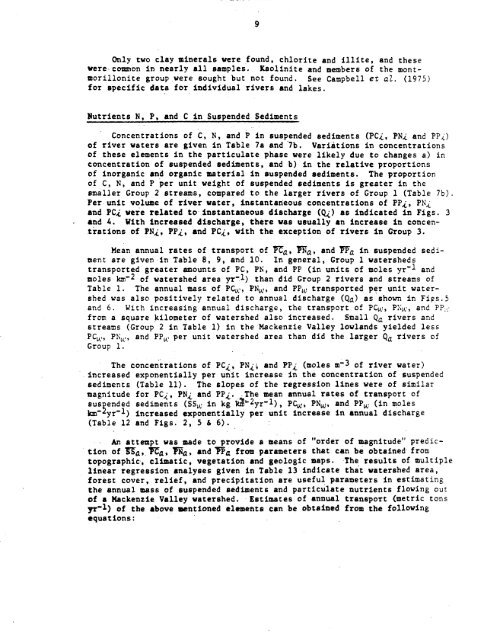The chemistry, mineralogy, and rates of transport of sediments in the ...
The chemistry, mineralogy, and rates of transport of sediments in the ...
The chemistry, mineralogy, and rates of transport of sediments in the ...
You also want an ePaper? Increase the reach of your titles
YUMPU automatically turns print PDFs into web optimized ePapers that Google loves.
9<br />
Only two clay m<strong>in</strong>erals were found, chlorite <strong>and</strong> illite, <strong>and</strong> <strong>the</strong>se<br />
were, common <strong>in</strong> nearly all samples . Kaol<strong>in</strong>ite <strong>and</strong> members <strong>of</strong> <strong>the</strong> montmorillonite<br />
group . were sought but not found . See Campbell et aZ . (1975)<br />
for specific data for <strong>in</strong>dividual rivers <strong>and</strong> lakes .<br />
Nutrients N, P, <strong>and</strong> C <strong>in</strong> Suspended Sediments<br />
Concentrations <strong>of</strong> C, N, <strong>and</strong> P <strong>in</strong> suspended <strong>sediments</strong> (PC1,, PN : <strong>and</strong> PPS)<br />
<strong>of</strong> river waters are given <strong>in</strong> Table 7a <strong>and</strong> 7b . Variations <strong>in</strong> concentrations<br />
<strong>of</strong> <strong>the</strong>se elements <strong>in</strong> <strong>the</strong> particulate phase were likely due to changes a) <strong>in</strong><br />
concentration <strong>of</strong> suspended <strong>sediments</strong>, <strong>and</strong> b) <strong>in</strong> <strong>the</strong> relative proportions<br />
<strong>of</strong> <strong>in</strong>organic <strong>and</strong> organic material <strong>in</strong> suspended <strong>sediments</strong> . <strong>The</strong> proportion<br />
<strong>of</strong> C, N, <strong>and</strong> P per unit weight <strong>of</strong> suspended <strong>sediments</strong> is greater <strong>in</strong> <strong>the</strong><br />
smaller Group 2 streams, compared to <strong>the</strong> larger rivers <strong>of</strong> Group 1 (Table 7b) .<br />
Per unit volume <strong>of</strong> river water, <strong>in</strong>stantaneous concentrations <strong>of</strong> PP, :, PN,-<br />
<strong>and</strong> PC, : were related to <strong>in</strong>stantaneous discharge (Qi) as <strong>in</strong>dicated <strong>in</strong> Figs . 3<br />
<strong>and</strong> 4 . With <strong>in</strong>creased discharge, <strong>the</strong>re was usually an <strong>in</strong>crease <strong>in</strong> concentrations<br />
<strong>of</strong> PN1, PP, :, <strong>and</strong> PC, :, with <strong>the</strong> exception <strong>of</strong> rivers <strong>in</strong> Group 3 .<br />
Mean annual <strong>rates</strong> <strong>of</strong> <strong>transport</strong> <strong>of</strong> na, P91a, <strong>and</strong> gPQ <strong>in</strong> suspended sediment<br />
are given <strong>in</strong> Table 8, 9, <strong>and</strong> 10 . In general, Group 1 watersheds<br />
<strong>transport</strong>ed greater amounts <strong>of</strong> PC, PN, <strong>and</strong> PP (<strong>in</strong> units <strong>of</strong> moles yr'1 <strong>and</strong><br />
moles k<strong>in</strong>-2 <strong>of</strong> watershed area yr'l) than did Group 2 rivers <strong>and</strong> streams <strong>of</strong><br />
Table 1 . <strong>The</strong> annual mass <strong>of</strong> PCW, PNu,, <strong>and</strong> PPW <strong>transport</strong>ed per unit watershed<br />
was also positively related to annual discharge (QQ) as shown <strong>in</strong> FiRs .5<br />
<strong>and</strong> 6 . With <strong>in</strong>creas<strong>in</strong>g annual discharge, <strong>the</strong> <strong>transport</strong> <strong>of</strong> PCW, PNw, <strong>and</strong> PP ; .. .<br />
from a square kilometer <strong>of</strong> watershed also <strong>in</strong>creased . Small Qa rivers <strong>and</strong><br />
streams (Group 2 <strong>in</strong> Table 1) <strong>in</strong> <strong>the</strong> Mackenzie Valley lowl<strong>and</strong>s yielded less<br />
PCW, PNu., <strong>and</strong> PP,, ., per unit watershed area than did <strong>the</strong> larger Qa rivers <strong>of</strong><br />
Group 1 .<br />
<strong>The</strong> concentrations <strong>of</strong> PC, :, PN1 <strong>and</strong> PP, : (moles m'3 <strong>of</strong> river water)<br />
.<strong>in</strong>creased exponentially per unit <strong>in</strong>crease <strong>in</strong> <strong>the</strong> concentration <strong>of</strong> suspended<br />
<strong>sediments</strong> (Table 11) . <strong>The</strong> slopes <strong>of</strong> <strong>the</strong> regression l<strong>in</strong>es were <strong>of</strong> similar<br />
magnitude for PC, :, PN: <strong>and</strong> PP,: . - :<strong>The</strong> mean annual <strong>rates</strong> <strong>of</strong> <strong>transport</strong> <strong>of</strong><br />
suspended <strong>sediments</strong> (SSW <strong>in</strong> kg k~'2yr'1), PCW, PNW, <strong>and</strong> PPW (<strong>in</strong> moles<br />
km- yr-1) <strong>in</strong>creased exponentially per unit <strong>in</strong>crease <strong>in</strong> annual discharge<br />
(Table 12 <strong>and</strong> Figs . 2, 5 & 6) .<br />
An attempt was made to provide a means <strong>of</strong> "order <strong>of</strong> magnitude" prediction<br />
<strong>of</strong> na, . Ts a, TNQ, <strong>and</strong> TPQ from parameters that can be obta<strong>in</strong>ed from<br />
topographic,, climatic, vegetation <strong>and</strong> geologic maps . <strong>The</strong> results <strong>of</strong> multiple<br />
l<strong>in</strong>ear regression analyses given <strong>in</strong> Table 13 <strong>in</strong>dicate that watershed area,<br />
forest cover, relief, <strong>and</strong> precipitation are useful parameters <strong>in</strong> estimat<strong>in</strong>g<br />
<strong>the</strong> annual mass <strong>of</strong> suspended <strong>sediments</strong> <strong>and</strong> particulate nutrients flow<strong>in</strong>g out<br />
<strong>of</strong> a Mackenzie Valley watershed . -Estimates <strong>of</strong> annual <strong>transport</strong> (metric tons<br />
yr-1) <strong>of</strong> <strong>the</strong> above mentioned elements can be obta<strong>in</strong>ed from <strong>the</strong> follow<strong>in</strong>g<br />
equations :
















